Extra Questions for Class 10 Science Chapter 12 Electricity
Get extra questions for Class 10 Science Chapter 12 Electricity with PDF. Our subject expert prepared these solutions as per the latest NCERT textbook. These extra questions will be helpful to revise the important topics and concepts. You can easily download all the questions and answers in PDF format from our app.
Electricity Class 10 Science Extra Questions with Answers
Question 1: Write S.I. unit of resistivity.
Answer: Ohm-metre (Ωm).
Question 2: Name a device that helps to maintain a potential difference across a conductor.
Answer: Cell or battery
Question 3: Write relation between heat energy produced in a conductor when a potential difference V is applied across its terminals and a current I flows through for ‘t’
Answer: Heat produced, H = VIt
Question 4: State difference between the wire used in the element of an electric heater and in a fuse wire.
Answer: The wire used in the element of electric heater has a high resistivity and have a high melting point, i.e. even at a high temperature element do not burn while fuse wire have a low melting point and high resistivity.
Question 5: How is an ammeter connected in a circuit to measure current flowing through it?
Answer: In series.
Question 6: What happens to resistance of a conductor when its area of cross-section is increased?
Answer: Resistance decreases as R∝1/A
Question 7: Two resistors of 10 Ω and 15 Ω are connected in series to a battery of 6 V. How can the values of current passing through them be compared?
Answer: In series, same current flows through each resistor. So, ratio of current is 1:1.
Question 8: How much current will an electric bulb draw from 220 V source if the resistance of the bulb is 1200Ω? If in place of bulb, a heater of resistance 100 Ω is connected to the sources, calculate the current drawn by it
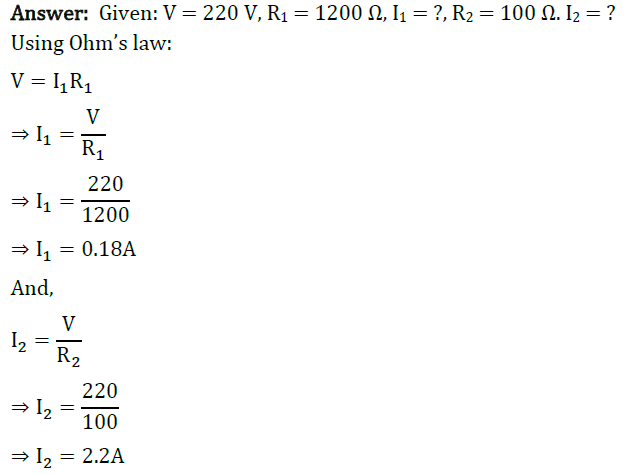
Question 9: Draw a schematic diagram of an electric circuit comprising of 3 cells and an electric bulb, ammeter, plug-key in the ON mode and another with same components but with two bulbs in parallel and a voltmeter across the combination.
Answer:
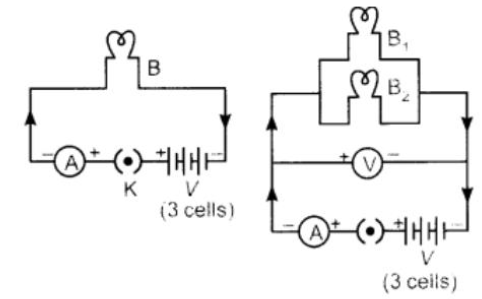
Question 10: Out of the two wires X and Y shown below, which one has greater resistance? Justify your answer.

Answer: Wire ‘Y’ has greater resistance as it has more length than wire ‘X’. It is because resistance of wire is directly proportional to the length of wire.
Question 11: A 9Ω resistance is cut into three equal parts and connected in parallel. Find the equivalent resistance of the combination.
Answer:
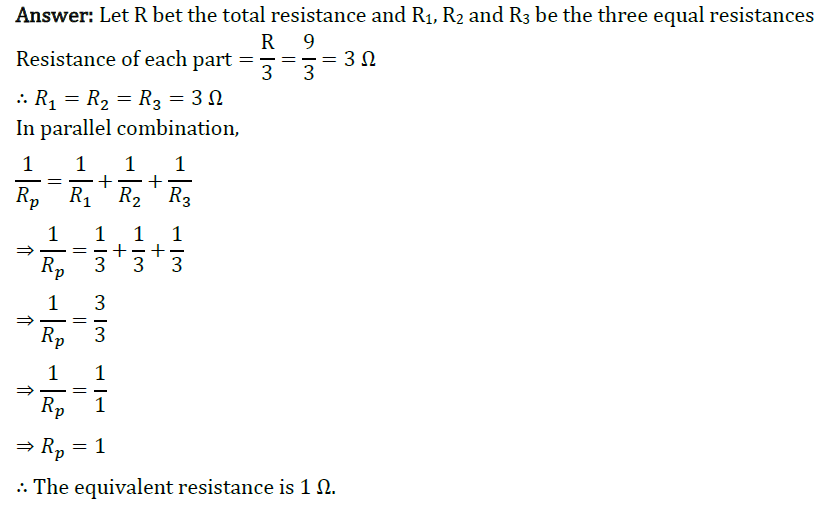
Question 12: (a) What do the following circuit symbols represent?
(b) The potential difference between the terminals of an electric heater is 60 V when it draws a current of 4 A from the source. Find the resistance of heater when in use.
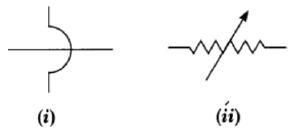
Answer: (a) (i) Wires crossing without touching each other.
(ii) Rheostat/Variable resistor
(b) Given: V = 60 V, I = 4 A, R = ?
From Ohm’s law, V = IR
⇒ 60 = 4 × R
⇒ R = 15 Ω
Question 13: The charge possessed by an electron is 1.6 × 10-19 coulombs. Find the number of electrons that will flow per second to constitute a current of 1 ampere.
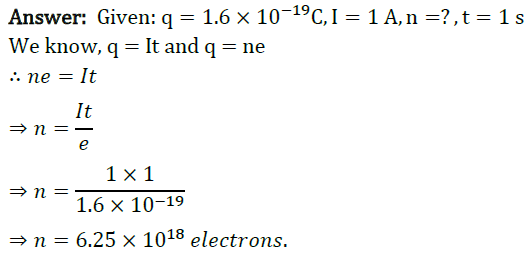
Question 14: Explain the role of fuse in series with any electrical appliance in an electric circuit. Why should a fuse with defined rating for an electric circuit not be replaced by one with a larger rating?
Answer: Fuse wire is a safety device connected in series with the live wire of circuit. It has high resistivity and low melting point. It melts when a sudden urge of large current passes through it and disconnects the entire circuit from the electrical supply. But, in case if we use a larger rating instead of a defined rating, then it will not protect the circuit as high current will easily pass through it and it will not melt.
Question 15: The wattage of a bulb is 24 W when it is connected to a 12 V battery. Calculate its effective wattage if it operates on a 6 V battery (Neglect the change in resistance due to unequal heating of the filament in the two cases).
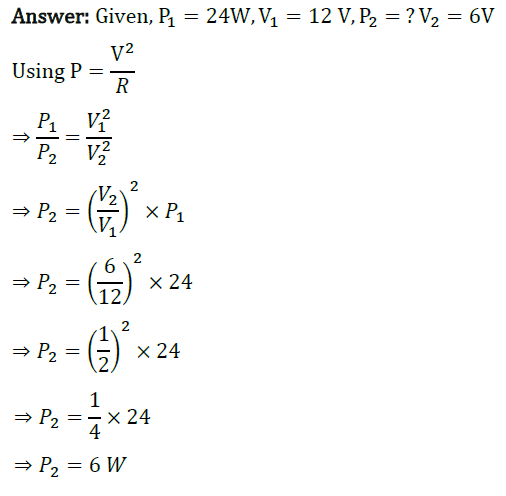
Question 16: In an experiment to study the relation between the potential difference across a resistor and the current through it, a student recorded the following observations:
| Potential difference (V) | 1.0 | 2.2 | 3.0 | 4.0 | 6.4 |
| Current (A) | 0.1 | 0.2 | 0.6 | 0.4 | 0.6 |
On examine the above observations, the teacher asked the student to reject one set of readings as the values were out of agreement with the rest. Which one of the above sets of readings can be rejected? Calculate the mean value of resistance of the resistor based on the remaining four sets of readings.
Answer: The third reading for V = 3.0 volt and I = 0.6 A will be rejected as it has larger deviation from the rest of the readings.
The value of resistance in the other four observations will be I (using R = V/I) 10Ω, 11 Ω, 10 Ω and 10.67 Ω.
So, the mean value of resistance = 41.67/4 = 10.417 = 10.42 Ω
Question 17: What is an electric circuit? Distinguish between an open and a closed circuit.
Answer: An arrangement for maintaining the continuous flow of electric current by the electrical energy source through the various electrical components connected with each other by conducting wires is termed as electric circuit.
An open circuit does not carry any current, while a closed circuit carries current.
Question 18: Study the following electric circuit and find (i) the current flowing in the circuit and (ii) the potential difference across 10 Ω resistor.
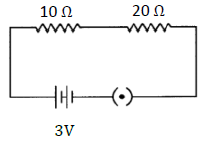
Answer: 10 Ω and 20 v are connected in series, their equivalent resistance is
RS = R1 + R2
⇒ RS = 10+20
⇒ RS = 30 Ω
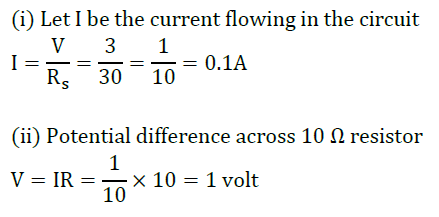
Question 19: Define 1 volt. Express it in terms of SI unit of work and charge calculate the amount of energy consumed in carrying a charge of 1 coulomb through a battery of 3 V.
Answer: When 1 joule of work is done in carrying 1 coulomb of charge, from infinity to a point in the electric field, then potential at that point is called 1 volt. Potential difference between two points is
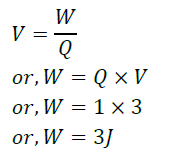
Question 20: V-I graph for two wires A and B are shown in the figure. If both wires are of same length and same thickness, which of the two is made of a material of high resistivity? Give justification for your answer.
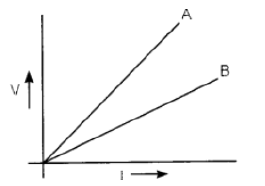
Answer: Greater than slope of V-I graph, greater will be the resistance of given metallic wire. In the given graph, wire A has greater slope then B. Hence, wire A has greater resistance.
For the wires of same length and same thickness, resistance depends on the nature of material of the wire, i.e.,
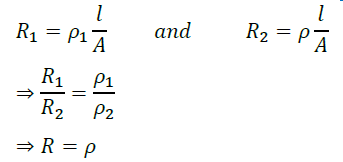
Hence, wire ‘A’ is made of a material of high resistivity.
Question 21: The figure below shows three cylindrical copper conductors along with their face areas and lengths. Discuss in which geometrical shape the resistance will be highest.
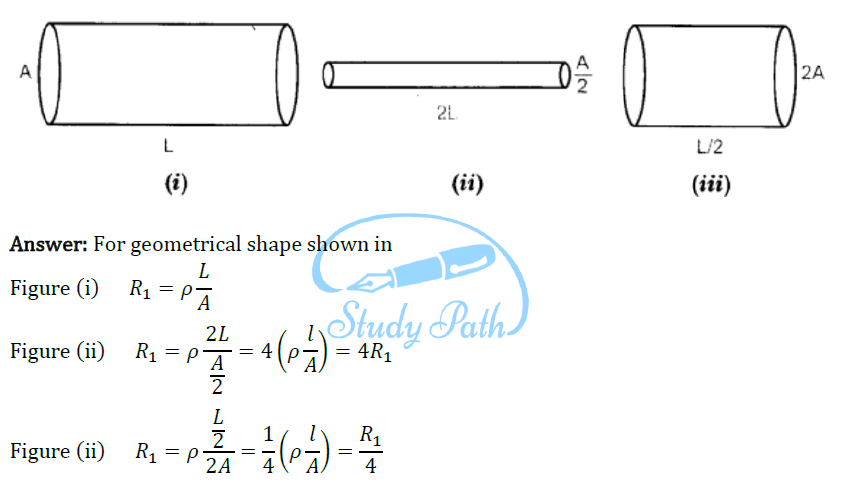
Question 22: An electric bulb of resistance 200Ω draws a current of 1 Ampere. Calculate the power of the bulb the potential difference at its ends and the energy in kWh consumed burning it for 5h.
Answer: Power of the bulb,
P = I2R
P = 12 × 200
P = 200 W
Energy consumed by bulb in 5h in burning = Power × Time
= 200 × 5
= 1000 Wh
= 1KWh
Question 23: Two identical wires one of nichrome and other of copper are connected in series and a current (I) is passed through them. State the change observed in the temperatures of the two wires. Justify your answer. State the law which explains the above observation.
Answer: The resistivity of nichrome is more than that of copper so its resistance is also high. Therefore, large amount of heat is produced in the nichrome wire for the same current as compared to that of copper wire. Accordingly, more change in temperature is observed in the nichrome wire. This is explained by Joule’s law of heating.
Joule’s law of heating: It states that the amount of heat produced in a conductor is
(i) directly proportional to the square of current flowing through it, i.e., H ∝ I2
(ii) directly proportional to the resistance offered by the conductor to the current, ie., H ∝ R
(iii) directly proportional to the time for which current is flowing through it, i.e.,
H ∝ t
Combining these, we get
H ∝ I2Rt
⇒ H = KI2Rt
Where K is proportionality constant and in SI system, it is equal to one.
Question 24: An electric bulb is rated at 60 W, 240 V. Calculate its resistance. If the voltage drops to 192 V, calculate the power consumed and the current drawn by the bulb. (Assume that the resistance of the bulb remain unchanged.)
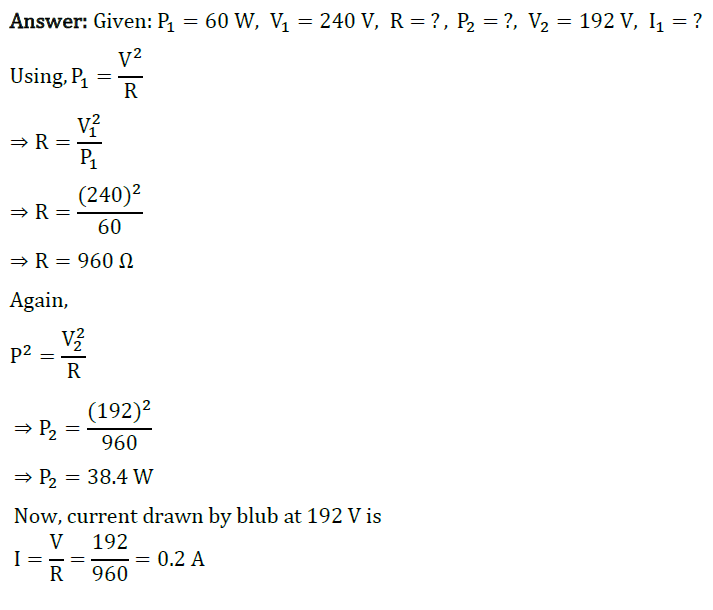
Question 25: A torch bulb is rated 2.5 V and 750 mA. Calculate (i) its power, (ii) its resistance and (iii) the energy consumed, if this bulb is lighted for four hours.
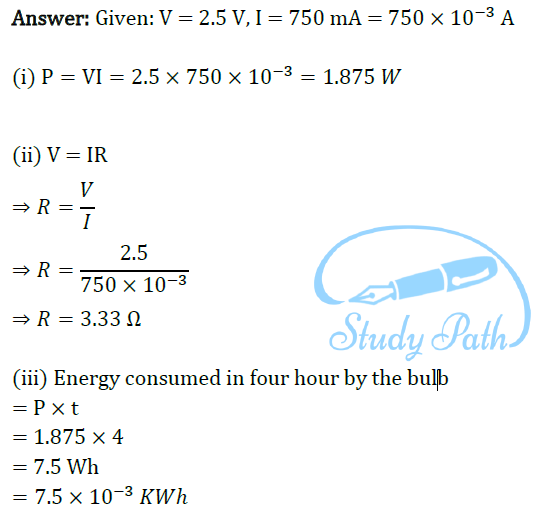
Question 26: Series arrangements are not used for domestic circuits. List any three reasons.
Answer: Series arrangements are not used for domestic circuit because
- The electrical appliances need current of widely different values to operate properly.
- In series arrangement, when one component fails, the circuit is broken and none of the components works.
- All electrical appliances work at a constant voltage. But in series circuit, the current is constant throughout the electric circuit and potential is different across the different components. So, series arrangement is not suitable for domestic circuits.
Question 27: Name the physical quantity which is (i) same (ii) different in all the bulbs when three bulbs of:
(a) same wattage are connected in series.
(b) same wattage are connected in parallel.
(c) different wattage are connected in series.
(d) different wattage are connected in parallel.
Answer: (a) For identical bulbs in series- same current, same potential difference.
(b) For identical bulbs in parallel- same potential difference, different current.
(c) For unidentical bulbs in series- same current, different potential difference.
(d) For unidentical bulbs in parallel- different current, same potential difference.
Question 28: Two devices of rating 44 W, 220 V and 11 W, 220 V are connected in series. The combination is connected across a 440V mains. The fuse of which of the two devices is likely to burn when the switch is ON? Justify your answer.
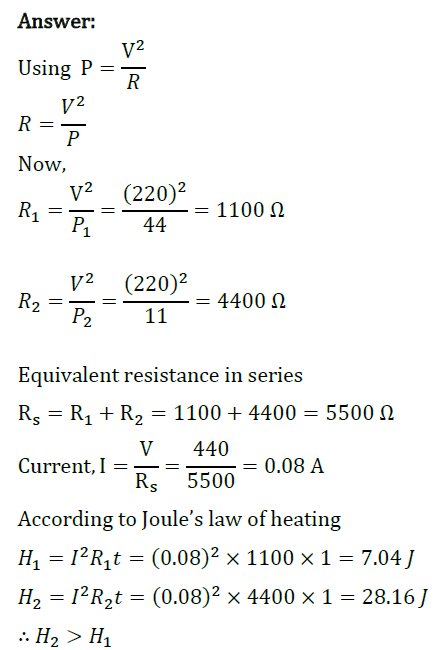
Question 29: Two resistors with resistances 5Ω and 10 Ω are to be connected to a battery of emf 6 V so as to obtain:
(i) minimum current
(ii) maximum current
(a) How will you connect the resistances in each case?
(b) Calculate the strength of the total current in the circuit in the two cases.
Answer: (a) As current is inversely proportional to resistance for the same voltage. So, to get maximum current, the equivalent resistance has to be less. This means the resistors must be connected in parallel. To get minimum current, the equivalent resistance has to be greater as I∝1/R. This means the resistors must be connected in series.
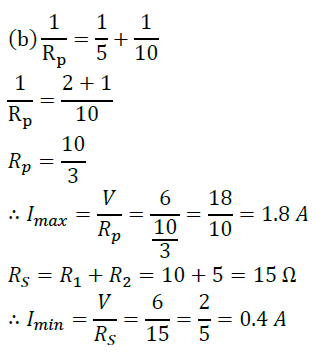
Question 30: (a) Define the term ‘volt’.
(b) State the relation between work, charge and potential difference for an electric circuit. Calculate the potential difference between the two terminals of a battery if 100 J of work is required to transfer 20 C of charge from one terminal of the battery to the other.
Answer: (a) When 1 joule of work is done in carrying 1 coulomb of charge, from infinity to a point in the electric field, then potential at that point is called 1 volt.
(b) Potential difference, V = Work done on unit charge =W/q
Work is 100J, q=20C
Potential difference, V= W/q = 100/20 = 5V
Question 31: Define the term ‘coulomb’.
Answer: When 1 A current flows across the wire in 1 second, the charge transfer across its ends is said to be 1 coulomb.
Question 32: (a) How is the direction of electric current related to the direction of flow of electrons in a wire?
(b) Calculate the current in a circuit if 500 C of charge passes through it in 10 minutes.
Answer: (a) Conventional direction of electric current is opposite to the direction of flow of electrons in a wire.
